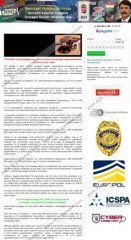Nemzeti Védelmi Szolgálat Virus Removal Guide
Nemzeti Védelmi Szolgálat Virus is also known as the Paysafecard Virus because cyber criminals use this well-known money transfer system in order to collect fictitious fines presented within a bogus screen-locking alert which you are introduced to as soon as the infection is activated. How did it enter your seemingly secure computer? You can blame the malicious Urausy Trojan. This dreadful program uses rootkit files to conceal the presence of the malignant processes which you should remove. As soon as the threat utilizes drive-by download scams to enter and settle within your PC, a fictitious ransomware notification is flaunted on top of the screen, and this is the cue for Nemzeti Védelmi Szolgálat Virus removal. Firstly, let's overview the fictitious infection and its ridiculous demands:
A számitógépe meg van blokkolva a biztonsági megfontolásokból a következo okok miatt.
Az On birsága összege HUF 25000 (Ft) Magyar forint.
A bírságot voucherekkel PaySafeCard fizetheti.
Needless to say, if schemers locked the system with a blunt demand to pay money in return of the restored access to the system, there would not be as many victims as Nemzeti Védelmi Szolgálat Virus manages to assemble. In order to trick more Windows users, schemers have designed the screen-locking notification to look like an authentic warning presented by the Europol, ICSPA, Cyber Crime Unit, Copyright Alliance and other well-know organizations which in general are unlikely to lock your system without your knowledge. According to our spyware researchers, schemers have used this trick to fool Hungarian Windows users attacked by Az ön számítógépe blokkolásra került Virus, Magyarország Rendőrség Police Virus, Police Rendőrség Virus and similar ransomware infections. All of them can be removed in the exact same manner.
If you are inexperienced with spyware removal, there is no doubt that getting Nemzeti Védelmi Szolgálat Virus deleted seems extremely difficult. In full honesty, it is not an easy task to even Windows experts, which is why all targeted computers should be inspected and cleaned by automatic spyware detection and removal software. After the threat is deleted, you should ensure that the system is safeguarded by reliable security tools. Do you want to catch two birds with one stone? Then install SpyHunter, a tool which will ensure effective spyware removal and reliable Windows protection.
How to delete ransomware from Windows?
Delete from Windows XP:
- Restart the computer and wait for the moment BIOS loads up.
- Start tapping F8 until the boot menu shows up.
- Use arrow keys to select Safe Mode with Networking and tap Enter.
- Once prompted with the safe mode confirmation alert – click YES.
- Visit http://www.411-spyware.com/download-sph and download an authentic spyware remover.
- Open the Start menu and click RUN.
- Type in msconfig and click OK. This opens the System Configuration Utility.
- Click the Startup tab, uncheck all listed items and hit OK.
- Restart the PC, install SpyHunter and delete all running computer infections.
Delete from Windows Vista/Windows 7:
- Repeat steps 1-3 (see removal instructions above).
- Go to http://www.411-spyware.com/spyhunter and follow the installation instructions.
- Once the program is installed, scan the computer and remove PC corrupting spyware.
Delete from Windows 8:
- Tap the Windows key on the keyboard. In the Metro UI start screen launch a web browser.
- Download an automatic spyware detection and removal tool SpyHunter.
- Without further delay install the application and remove all dangerous computer threats.
Nemzeti Védelmi Szolgálat Virus Screenshots:


